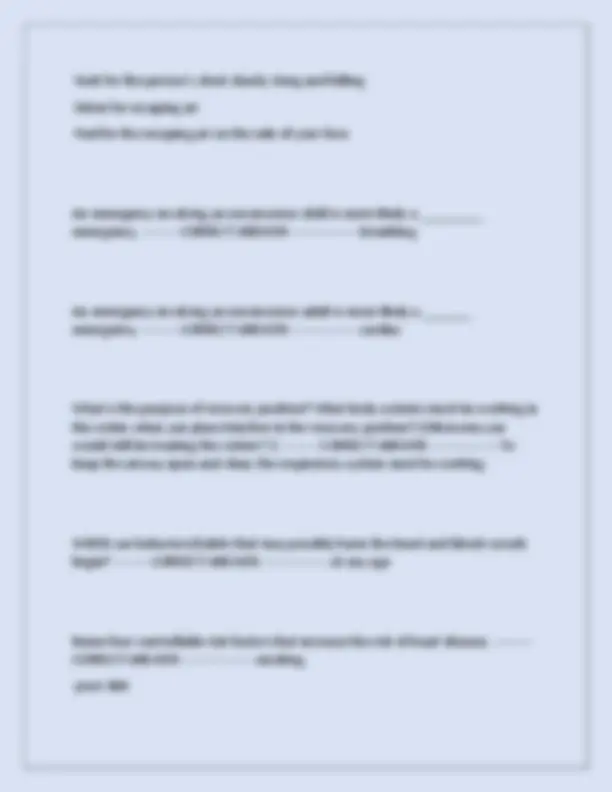

































Study with the several resources on Docsity

Earn points by helping other students or get them with a premium plan


Prepare for your exams
Study with the several resources on Docsity

Earn points to download
Earn points by helping other students or get them with a premium plan
Community
Ask the community for help and clear up your study doubts
Discover the best universities in your country according to Docsity users
Free resources
Download our free guides on studying techniques, anxiety management strategies, and thesis advice from Docsity tutors
The "American Red Cross First Aid, CPR, and AED Complete Exam 2025" document serves as an essential guide for students preparing for first aid certification, covering critical areas like CPR, AED use, and emergency response strategies. This resource is ideal for individuals seeking to enhance their knowledge and skills in emergency medical care, particularly those aiming to pass the certification exam with a high grade. The document provides detailed explanations of various emergency scenarios and the appropriate responses. Topics include handling situations where a victim vomits during ventilation, with the correct first step of turning the victim to prevent choking. It also covers the procedure for aiding a conscious infant who is choking using chest thrusts with two or three fingers. For cases where a victim is unresponsive but breathing, the document emphasizes the importance of positioning them in a recovery position while awaiting EMS personnel.
Typology: Exams
1 / 39

This page cannot be seen from the preview
Don't miss anything!
































As you are giving ventilations with a resuscitation mask, the victim vomits. Which of the following would you do first? ---------CORRECT ANSWER-----------------As you are giving ventilations with a resuscitation mask, the victim vomits. Which of the following would you do first You are providing care to a conscious infant who is choking. When giving chest thrusts, which of the following would you use? ---------CORRECT ANSWER------------ -----Two or three fingers You determine that a victim is unresponsive but breathing. While waiting with the victim for EMS personnel, you would position the victim: ---------CORRECT ANSWER-----------------In a recovery position. While preparing to use an automated external defibrillator (AED) on a victim, you notice a medication patch on the victim's chest. Which action is most appropriate? ---------CORRECT ANSWER-----------------Removing the patch with a gloved hand.
Which of the following statements about bag-valve-mask resuscitators (BVMs) is most accurate? ---------CORRECT ANSWER-----------------Ventilations are more effective when two rescuers operate the BVM. When giving chest compressions to an adult, how would you position your hands? ---------CORRECT ANSWER-----------------Heel of one hand on the center of the chest with the other hand on top Which of the following statements about performing CPR with two or more rescuers is true? ---------CORRECT ANSWER-----------------To reduce rescuer fatigue, rescuers should switch positions about every two minutes or when the AED is analyzing. You are performing CPR on a victim and an assisting responder arrives. Which of the following is most appropriate for the assisting responder to do first? --------- CORRECT ANSWER-----------------Check to see whether EMS personnel have been called. Which of the following findings would lead you to determine that an infant's airway is open and not obstructed? ---------CORRECT ANSWER-----------------The infant is crying uncontrollably.
Which of the following statements about bag-valve-mask resuscitators (BVMs) is most accurate? ---------CORRECT ANSWER-----------------Ventilations are more effective when two rescuers operate the BVM. You are preparing to give ventilations to a 5-year-old child using a resuscitation mask. You should give 1 ventilation about every ---------CORRECT ANSWER----------- ------3 seconds. When performing chest compressions during CPR, you should give compressions at a rate of at least how many compressions per minute? ---------CORRECT ANSWER-----------------Between 100 and 120 An AED has advised that a shock should be given. Which of the following is appropriate? ---------CORRECT ANSWER-----------------Tell everyone to stand clear of the victim. You are about to apply AED pads to a victim's chest when you notice that the victim has several body piercings with jewelry on their chest. Which of the following should you do? ---------CORRECT ANSWER-----------------Apply the pads to the chest, at least 1 inch away from the jewelry.
The cycle of chest compressions and ventilations in two-rescuer CPR for an infant is: ---------CORRECT ANSWER-----------------15 chest compressions and 2 ventilations. You are using a resuscitation mask to give ventilations to a child. After you position and seal the mask, which of the following should you do next? --------- CORRECT ANSWER-----------------Tilt the victim's head back to open the airway You are providing care to a patron who started choking on some food. The victim becomes unresponsive. Which of the following should you do first --------- CORRECT ANSWER-----------------Lower the victim to the ground and begin CPR starting with chest compressions. Where should you place your hands when giving chest compressions to an infant during CPR? ---------CORRECT ANSWER-----------------One hand on the forehead and two or three fingers on the center of the chest. When giving abdominal thrusts to an adult who is choking, where should you position your fist? ---------CORRECT ANSWER-----------------In the middle of the abdomen, just above the navel
During a swim meet, the bleachers behind your guard station suddenly collapse. As you check the scene, you notice several people who appear injured. Who should you approach first? ---------CORRECT ANSWER-----------------A victim who appears unconscious. How can you best protect yourself from possible bloodborne pathogen transmission when providing care? ---------CORRECT ANSWER-----------------Use personal protective equipment (PPE), such as disposable gloves and a breathing barrier, when providing care. A 12-year-old child at a swim meet grabs their chest and begins to make wheezing noises. After you obtain consent to provide care, the child's parent informs you that the child has a history of asthma, but does not have an inhaler nearby. What care should you provide? ---------CORRECT ANSWER-----------------Summon more advanced medical personnel and place the victim into a position that helps breathing. Your initial impression of a victim is based on: ---------CORRECT ANSWER------------- ----How the victim appears to you as you size up the scene. You and another lifeguard find an unresponsive adult on the floor in the locker room. You activate your facility's EAP, size-up the scene, form an initial impression and perform a primary assessment. You find the victim is not moving or breathing, but has a pulse. You should summon EMS personnel, then: ---------
CORRECT ANSWER-----------------Give ventilations at a rate of 1 about every 5- 6 seconds. You arrive on the scene where a patron appears to be injured. Before approaching the victim, which of the following will you NOT do as you size-up the scene? ---------CORRECT ANSWER-----------------Begin performing the primary assessment. When providing care during an emergency, which of the following should you do first? ---------CORRECT ANSWER-----------------Size-up the scene while forming an initial impression. As the first rescuer on the scene, you are performing CPR on an adult. When performing chest compressions, how deeply should you compress the chest ------- --CORRECT ANSWER-----------------At least 2 inches but no more than 2.4 inches CPR should be performed on which of the following victims? ---------CORRECT ANSWER-----------------One who is in cardiac arrest What is the first step of the Adult Cardiac Chain of Survival? ---------CORRECT ANSWER-----------------Recognition of a cardiac emergency and activation of the emergency response system.
You are providing care to a facility maintenance worker who has fallen off the top of a ladder. The victim is responsive. Which of the following should you do first? -- -------CORRECT ANSWER-----------------Obtain consent from the victim to provide care. For which of the following should you summon EMS personnel? ---------CORRECT ANSWER-----------------A victim with an open leg wound with the bone protruding When caring for musculoskeletal injuries, what does RICE stand for? --------- CORRECT ANSWER-----------------Rest, immobilize, cold, elevate All of the following are components of scene size-up EXCEPT: ---------CORRECT ANSWER-----------------Checking for responsiveness. Signs and symptoms of sudden illness do not include: ---------CORRECT ANSWER--- --------------Bruising or rigidness of the abdomen When checking a victim during a secondary assessment you notice changes in her LOC. What does the C stand for in LOC? ---------CORRECT ANSWER----------------- Consciousness.
You arrive on a scene where someone seems to be hurt. During the primary assessment, you should check for all of the following EXCEPT: ---------CORRECT ANSWER-----------------Swelling Which of the following would you identify as the universal sign that a conscious person is choking? ---------CORRECT ANSWER-----------------Clutching the throat Based on which of the following signs and symptoms would you determine that a victim is experiencing respiratory distress? ---------CORRECT ANSWER----------------- Gasping for breath You and another lifeguard find an unresponsive adult on the locker room floor. The other lifeguard goes to summon EMS personnel. You form an initial impression, complete a primary assessment and find that the victim has a pulse but is not breathing. Which of the following should you do next? ---------CORRECT ANSWER-----------------Give ventilations at a rate of about 1 every 5-6 seconds. You are providing care to an adult who is unresponsive and not breathing as a result of a drowning. You give your first ventilation before performing CPR and notice that the chest does not rise. Which of the following should you do next? --- ------CORRECT ANSWER-----------------Re-tilt the victim's head and then attempt another ventilation.
A patron has slurred speech, is unable to lift their right arm level with her left arm and is unable to smile without one side of their face drooping. You make note of the time the symptoms started. These are symptoms of: ---------CORRECT ANSWER-----------------A stroke. You are providing care to a patron who started choking on some food. The victim becomes unresponsive. Which of the following should you do first? --------- CORRECT ANSWER-----------------Lower the victim to the ground and begin CPR starting with chest compressions. Your initial impression reveals severe life-threatening bleeding in an adult victim who appears to be unresponsive. Your next step should be: ---------CORRECT ANSWER-----------------Control the bleeding with any available resources. A patron has cut their leg on the edge of the bleachers and is bleeding heavily. You think the patron is in shock because they: ---------CORRECT ANSWER------------- ----Become restless and irritable SAMPLE ---------CORRECT ANSWER-----------------signs and symptoms, allergies, medications, past medical history, last oral intake, events leading up to incident
List the four steps a lay responder (you) will take in an emergency --------- CORRECT ANSWER-----------------1. Recognize that an emergency exists
What are the 3 situations when you would have to move a victim? --------- CORRECT ANSWER------------------when you are faced with immediate danger (the scene is unsafe)
Under normal conditions, how long can a person be without oxygen before POSSIBLE brain damage occurs? ---------CORRECT ANSWER----------------- 4 - 6 minutes Define respiratory distress and respiratory arrest: ---------CORRECT ANSWER-------- ---------Distress: a condition in which breathing becomes difficult Arrest: a condition when breathing has stopped List 4 signals that indicate a person is in respiratory distress: ---------CORRECT ANSWER------------------trouble breathing or no breathing
In what situations do you stop giving care to a conscious choking victim? (LIST 3) -- -------CORRECT ANSWER------------------EMS takes over